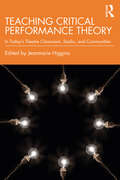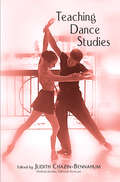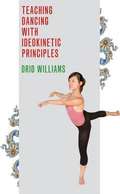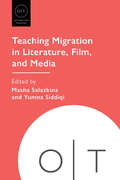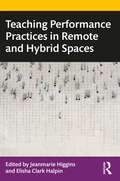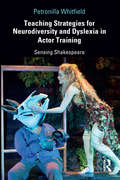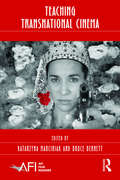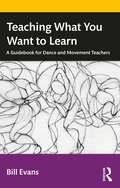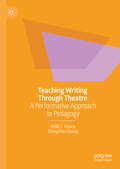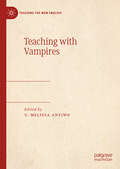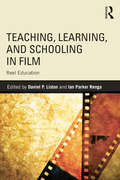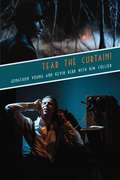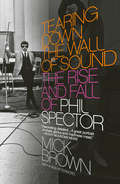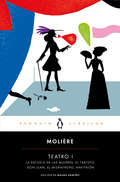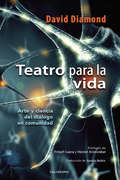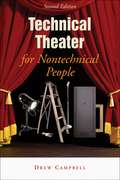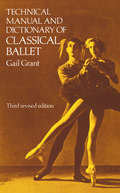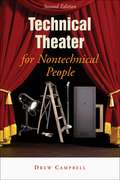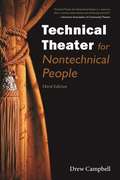- Table View
- List View
Teaching Critical Performance Theory: In Today’s Theatre Classroom, Studio, and Communities
by Jeanmarie HigginsTeaching Critical Performance Theory offers teaching strategies for professors and artist-scholars across performance, design and technology, and theatre studies disciplines. The book’s seventeen chapters collectively ask: What use is theory to an emerging theatre artist or scholar? Which theories should be taught, and to whom? How can theory pedagogies shape and respond to the evolving needs of the academy, the field, and the community? This broad field of enquiry is divided into four sections covering course design, classroom teaching, the studio space, and applied theatre contexts. Through a range of intriguing case studies that encourage thoughtful theatre practice, this book explores themes surrounding situated learning, dramaturgy and technology, disability and inclusivity, feminist approaches, race and performance, ethics, and critical theory in theatre history. Written as an invaluable resource for professionals and postgraduates engaged in performance theory, this collection of informative essays will also provide critical reading for those interested in drama and theatre studies more broadly.
Teaching Dance Studies
by Judith Chazin-Bennahum Melinda JordanTeaching Dance Studies is a practical guide, written by college professors and dancers/choreographers active in the field, introducing key issues in dance pedagogy. Many young people graduating from universities with degrees – either PhDs or MFAs – desire to teach dance, either in college settings or at local dance schools. This collection covers all areas of dance education, including improvisation/choreography; movement analysis; anthropology; theory; music for dance; dance on film; kinesiology/injury prevention; notation; history; archiving; and criticism. Among the contributors included in the volume are: Bill Evans, writing on movement analysis; Susan Foster on dance theory; Ilene Fox on notation; Linda Tomko addresses new approaches to teaching the history of all types of dance; and Elizabeth Aldrich writing on archiving.
Teaching Dancing with Ideokinetic Principles
by Drid WilliamsIn examining ideokinesis and its application to the teaching and practice of dancing, Drid Williams introduces readers to the work of Dr. Lulu Sweigard (1895–1974), a pioneer of ideokinetic principles. Drawing on her experiences during private instructional sessions with Sweigard over a two-year span, Williams discusses methods using imagery for improving body posture and alignment for ease of movement. Central to Williams's own teaching methods is the application of Sweigard's principles and general anatomical instruction, including how she used visual imagery to help prevent bodily injuries and increasing body awareness relative to movement. Williams also emphasizes the differences between kinesthetic (internal) and mirror (external) imagery and shares reactions from professional dancers who were taught using ideokinesis. Williams's account of teaching and practicing ideokinesis is supplemented with essays by Sweigard, William James, and Jean-Georges Noverre on dancing, posture, and habits. Teaching Dancing with Ideokinetic Principles offers an important historical perspective and valuable insights from years of teaching experience into how ideokinesis can shape a larger philosophy of the dance.
Teaching Film (Options for Teaching #35)
by Patricia White Mark Lynn Anderson Adam Lowenstein Hamid Naficy Dudley Andrew Timothy Corrigan Anne Rutherford Tasha Oren Garrett Stewart E. Ann Kaplan Gwendolyn Audrey Foster Michael Renov Pat Brereton David Desser Maureen Turim Paula J. Massood Michael Aronson Nataša Ďurovičová Mark LangerFilm studies has been a part of higher education curricula in the United States almost since the development of the medium. Although the study of film is dispersed across a range of academic departments, programs, and scholarly organizations, film studies has come to be recognized as a field in its own right. In an era when teaching and scholarship are increasingly interdisciplinary, film studies continues to expand and thrive, attracting new scholars and fresh ideas, direction, and research.Given the dynamism of the field, experienced and beginning instructors alike need resources for bringing the study of film into the classroom. This volume will help instructors conceptualize contemporary film studies in pedagogical terms. The first part of the volume features essays on theory and on representation, including gender, race, and sexuality. Contributors then examine the geographies of cinema and offer practical suggestions for structuring courses on national, regional, and transnational film. Several essays focus on interdisciplinary approaches, while others describe courses designed around genre (film noir, the musical), mode (animation, documentary, avant-garde film), or the formal elements of film, such as sound, music, and mise-en-scène. The volume closes with a section on film and media in the digital age, in which contributors discuss the opportunities and challenges presented by access to resources, media convergence, and technological developments in the field.
Teaching Film from the People's Republic of China (Options for Teaching)
by Zhuoyi Wang, Emily Wilcox, and Hongmei YuThis volume brings a diverse range of voices--from anthropology, communication studies, ethnomusicology, film, history, literature, linguistics, sociology, theater, and urban geography--into the conversation about film from the People's Republic of China. Essays seek to answer what films can reveal or obscure about Chinese history and society and demonstrate how studying films from the PRC can introduce students to larger issues of historical consciousness and media representation.The volume addresses not only postsocialist fictional films but also a wide variety of other subjects including socialist period films, documentaries, films by or about people from ethnic minority groups, film music, the perspectives of female characters, martial arts cinema, and remakes of South Korean films. By exploring how films represent power, traditions, and ideologies, students learn about both the complexity of the PRC and the importance of cross-cultural and cross-ideological understanding.
Teaching Migration in Literature, Film, and Media (Options for Teaching)
by Yumna Siddiqi Masha SalazkinaPeople migrate to seek opportunities, to unite with family, and to escape war, persecution, poverty, and environmental disasters. A phenomenon that has real, lived effects on individuals and communities, migration also carries symbolic, ideological significance. Its depiction in literature, film, and other media powerfully shapes worldviews, identities, attitudes toward migrants, and a political landscape that is both local and global. It is imperative, then, to connect the disciplinary and theoretical tools we have for understanding migration and to put them in conversation with students' experiences.Featuring a wide range of classroom approaches, this volume brings together topics that are often taught separately, including tourism, slavery, drug cartels, race, whiteness, settler colonialism, the Arab Spring, assimilation, and disability. Readers are introduced to terminology and legal frameworks and to theories of migration in relation to Black studies, ethnic studies, Asian American studies, Latinx studies, border studies, postcolonial studies, and Indigenous studies.
Teaching Performance Practices in Remote and Hybrid Spaces
by Jeanmarie HigginsThis collection of insightful essays gives teachers’ perspectives on the role of space and presence in teaching performance. It explores how the demand for remote teaching can be met while at the same time successfully educating and working compassionately in this most ‘live’ of disciplines. Teaching Performance Practices in Remote and Hybrid Spaces reframes prevailing ideas about pedagogy in dance, theatre, and somatics and applies them to teaching in face-to-face, hybrid, and remote situations. Case studies from instructors and professors provide essential, practical suggestions for remotely teaching a vast range of studio courses, including tap dance, theatre design, movement, script analysis, and acting, rendering this book an invaluable resource. The challenges that teachers are facing in the early twenty-first century are addressed throughout, helping readers to navigate these unprecedented circumstances whilst delivering lessons, guiding workshops, rehearsing, or even staging performances. This book is invaluable for dance and theatre teachers or leaders who work in the performing arts and related disciplines. It is also ideal for any professionals who need research-based solutions for teaching performance online.
Teaching Strategies for Neurodiversity and Dyslexia in Actor Training: Sensing Shakespeare
by Petronilla WhitfieldTeaching Strategies for Neurodiversity and Dyslexia in Actor Training addresses some of the challenges met by acting students with dyslexia and highlights the abilities demonstrated by individuals with specific learning differences in actor training. The book offers six tested teaching strategies, created from practical and theoretical research investigations with dyslexic acting students, using the methodologies of case study and action research. Utilizing Shakespeare’s text as a laboratory of practice and drawing directly from the voices and practical work of the dyslexic students themselves, the book explores: the stress caused by dyslexia and how the teacher might ameliorate it through changes in their practice the theories and discourse surrounding the label of dyslexia the visual, kinaesthetic, and multisensory processing preferences demonstrated by some acting students assessed as dyslexic acting approaches for engaging with Shakespeare’s language, enabling those with dyslexia to develop their authentic voice and abilities a grounding of the words and the meaning of the text through embodied cognition, spatial awareness, and epistemic tools Stanislavski’s method of units and actions and how it can benefit and obstruct the student with dyslexia when working on Shakespeare Interpretive Mnemonics as a memory support and hermeneutic process, and the use of color and drawing towards an autonomy in live performance This book is a valuable resource for voice and actor training, professional performance, and for those who are curious about emancipatory methods that support difference through humanistic teaching philosophies.
Teaching Transnational Cinema: Politics and Pedagogy (AFI Film Readers)
by Bruce Bennett Katarzyna MarciniakThis collection of essays offers a pioneering analysis of the political and conceptual complexities of teaching transnational cinema in university classrooms around the world. In their exploration of a wide range of films from different national and regional contexts, contributors reflect on the practical and pedagogical challenges of teaching about immigrant identities, transnational encounters, foreignness, cosmopolitanism and citizenship, terrorism, border politics, legality and race. Probing the value of cinema in interdisciplinary academic study and the changing strategies and philosophies of teaching in the university, this volume positions itself at the cutting edge of transnational film studies.
Teaching Tuk Tuk (Step into Reading)
by Mei NakamuraThis Step 2 Step into Reading leveled reader with more than 30 stickers is based on Disney's new animated film Raya and the Last Dragon!Discover how Raya and Tuk Tuk met and became friends in this Step 2 Step into Reading leveled reader! Children ages 4 to 6 will love this story based on the Disney animated film–with more than 30 stickers! Step 2 readers use basic vocabulary and short sentences to tell simple stories. For children who recognize familiar words and can sound out new words with help. Walt Disney Animation Studios' fantasy-action-adventure, Raya and the Last Dragon, introduces Raya, a lone warrior from the fantasy kingdom of Kumandra who teams up with a crew of misfits in her quest to find the last dragon and bring light and unity back to their world. Awkwafina lends her voice to Sisu, the last dragon, who was left on Kumandra in case dark forces return to the world, and Kelly Marie Tran voices the lead character, Raya. Exploring themes of community and hope, and inspired by the beautiful and diverse cultures of Southeast Asia, the fantasy-action-adventure Raya and the Last Dragon opened in U.S. theaters on March 12th 2021.
Teaching What You Want to Learn: A Guidebook for Dance and Movement Teachers
by Bill EvansTeaching What You Want to Learn distills the five decades that Bill Evans has spent immersed in teaching dance into an indispensable guide for today’s dance instructor. From devising specific pedagogical strategies and translating theory into action, to working with diverse bodies and embracing evolving value systems, Evans has considered every element of the teacher’s role and provided 94 essential essays about becoming a more effective and satisfied educator. As well as setting out his own particular training methods and somatic practice as one of the world's leading dance teachers, he explores the huge range of challenges and rewards that a teacher will encounter across their career. These explorations equip the reader not only to enable and empower their students but also to get the most out of their own work so they are learning as they teach. This is an essential book for anyone who wants to teach dance and movement, from professional and academic settings to amateur artists and trainee instructors.
Teaching Writing Through Theatre: A Performative Approach to Pedagogy
by Dongshin Chang Kelly I. AlianoThis volume presents an introspective study of writing pedagogy, explored through the lens of theatre and performance. The chapters explore assessment and issues related to student engagement, in both in-person and online learning spaces, and consider aspects such as class design, environment, activities, and curriculum. The authors draw on educational theory and inquiry-based pedagogy as well as their own experiences to lay out a comprehensive blueprint for teaching in a student centered classroom.
Teaching the Pig to Dance: A Memoir of Growing Up and Second Chances
by Fred ThompsonFred Thompson has enjoyed a remarkable career in Hollywood and politics, but when he sat down to write a memoir about how he got to be the person he is, he discovered that his best stories all seemed to come out of the years he spent growing up in and around his hometown of Lawrenceburg, Tennessee. It was a small town but not the smallest--after all, it was the county seat and it did have a courthouse, a couple of movie theaters, and its own Davy Crockett statue. For truly small, you had to travel to nearby Summertown, where the regular Sunday dinner was possum and chocolate gravy. But Lawrenceburg is where Fred got to be a kid, found his share of trouble and scrapes, came to know folks he didn't realize were so colorful at the time but sure does now, got married, had a few kids, became a man, and started his career as a country lawyer (pretty much in that order). And as Fred tells it, getting that law degree was something of a surprise for him, since in school he'd been less than stellar as a scholar. "Teaching Latin to someone like me," he says, "was like trying to teach a pig to dance. It's a waste of the teacher's time and it irritates the pig." In these reflections, as hilarious as they are honest and warm, Fred touches on the influences--family, hometown neighbors and teachers, team sports, jobs, romances, and personal crises--that molded his character, his politics, and the way he looks at life today. We get to know the unforgettable characters who congregated at the Blue Ribbon Cafe, like the rotund gentleman called "Shorty," whose claim to fame was his ability to quickly suck in his stomach and cause his pants to fall to the floor. Or Fred's Grandma Thompson, who became an early TV adopter for the sole purpose of watching Wrestling from Hollywood and who once had a "gourder" removed from her neck and subsequently walked around town with it in a handkerchief showing it to folks. One day Fred and an accomplice placed small explosive Fourth of July "cracker balls" under the four legs of their teacher's chair; Mrs. Garner sat down and, despite the racket, didn't flinch so much as a muscle--but Fred felt a twinge of the one emotion he hated most: shame. Fred idolized Coach Staggs from his high school football days, even though he was "like Captain Ahab without the humor" and didn't like smart alecks, comics, or individualists, which put the young Fred at a disadvantage. More than anyone else from those days though, Fred remembers his mom and dad, who taught him that kids are shaped most of all by the love and support they can take for granted. Teaching the Pig to Dance will delight everyone who admires Fred Thompson for his contributions to politics or for his work in movies and on TV, along with all those who just love to hear rollicking but unforgettable stories about growing up in a place where, as one of the local old-timers put it, "We weren't big enough to have a town drunk, so a few of us had to take turns."
Teaching with Vampires (Teaching the New English)
by U. Melissa AnyiwoThis edited volume provides pedagogical tools for those who teach – and would like to teach – with the most iconic of monsters: the vampire. Vampires are showing up with increasing frequency in the college classroom and there are a growing number of courses devoted solely to the Undead. This collection draws from a diverse range of teaching approaches, including the theoretical framing of vampire texts in a broad range of settings, that demonstrate the myriad of ways vampires are used to teach about marginalization, empathy, and inspire social justice. With chapters from global scholars, this essential text illustrates the burgeoning field of vampire studies and the popularity in classrooms at every level around the world, from gothic fiction to television courses.
Teaching, Learning, and Schooling in Film: Reel Education
by Ian Renga Daniel ListonFilms about education provide many of the most popular interpretations of what teaching and learning mean in schools. An analysis of this medium reveals much about the historical, cultural, political, and philosophical dimensions of education. Timely and engaging, this book fills a gap for scholarly and informed public commentary on the portrayal of education in film, offering a wide range of conceptual and interpretive perspectives. Teaching, Learning, and Schooling in Film explores several key questions, including: What does it mean to be a good teacher? How do these good teachers instruct? When is and what makes teaching complex? What constitutes learning? Do educational reforms work? The book’s interdisciplinary group of contributors answers these important questions in essays highlighting Hollywood, independent, and documentary films. Prospective and practicing teachers will engage with the thought-provoking educational issues raised in this book and gain insight into the complexities of teaching and learning portrayed in film.
Team Piano Repertoire: A Manual of Music for Multiple Players at One or More Pianos
by Frederic Ming Chang Albert FaurotListing of classical musical pieces written for 2 or more piano players
Tear the Curtain!
by Jonathon Young Kim Collier Kevin KerrIn this psychological thriller set in a fictionalized 1930s Vancouver, Alex Braithwaite, a troubled but passionate theatre critic, believes he has found the legendary Stanley Lee, director of the infamous avant-garde theatre "The Empty Space." Alex becomes convinced that this man's radically subversive ideas are what the artistic community of the city needs to shatter audience complacency. In his pursuit of the truth behind Stanley Lee's mysterious disappearance and his artistic ideas, Alex becomes caught between the warring factions of two prominent mob families - one controlling the city's playhouses, the other its cinemas, but both ensnared by the Empty Space Society. At the dawn of the Talkies, can Alex tear through the artifice of these art forms in time to save the city's art community from ripping itself apart?The play's collaborators found inspiration within the walls of Vancouver's Stanley Theatre, a space that has a dual history as a cinema and vaudeville house. Fittingly, this gritty film-noir production became an exploration of the two kinds of art and how they affect the audience. Tear the Curtain! explores global issues that consider what we want from art: to be shocked and surprised or for order to be restored.Cast of 2 women and 8 men.
Tearing Down the Wall of Sound: The Rise and Fall of Phil Spector
by Mick BrownIn December 2002 Phil Spector -- legendary record producer, legendary control freak, legendary recluse -- sat down on a sofa in his Los Angeles castle and gave his first major interview for twenty-five years. The journalist he talked to was Mick Brown. Shortly afterward, Phil Spector was arrested for murder. Over the course of that day, Spector spoke with extraordinary candor about his life and career; his mercurial rise to become the most successful record producer of the sixties; the genius that had been both a blessing and a curse; his creation of a sound never before heard in music; his trademark 'Wall of Sound'; his fragile mental state and his years on the brink of insanity. 'I've been a very tortured soul', said Spector. 'I have not been happy. I have devils inside that fight me'. The interview with Spector (described by MOJO as 'one of the most famous interviews in rock journalism') appeared as a cover story in the Telegraph magazine on 1 February 2003. Twenty-four hours later, a Hollywood actress named Lana Clarkson was shot dead in Spector's castle. Phil Spector was immediately arrested, and later released on $1m bail to await trial. Tearing Down the Wall of Sound is Mick Brown's personal odyssey into the heart of the strange life and times of Phil Spector. Beginning with that fateful meeting in Spector's home, and recounting the story of his colourful life and career, including the unfolding of the Clarkson case, this is one of the most bizarre and compelling stories in the annals of pop music.
Teatro I: La escuela de las mujeres / El tartufo / Don Juan / El misántropo / Anfitrión
by MolièreUno de los mayores dramaturgos europeos en una edición magistral a cargo de Mauro Armiño. El presente volumen, primero de dos dedicados al teatro de Molière, reúne cinco de sus grandes comedias, estrenadas entre 1662 y 1668, cuando su compañía conquistó los escenarios de París. En La escuela de las mujeres tuvo su primer gran éxito; con El Tartufo desató el escándalo; en Don Juan enriqueció un nuevo mito europeo; con El misántropo ofreció un agudo análisis de la necedad; y en Anfitrión parodió los entresijos de la corte. En conjunto, estas piezas geniales no solo exponen las flaquezas humanas, sino que castigan con el ridículo a quienes más a salvo se creen de ellas. Nuestra edición, a cargo de Mauro Armiño, uno de los mejores traductores y críticos literarios de la actualidad, se completa con una espléndida introducción, notas explicativas y noticias sobre el contexto histórico-literario de las comedias.
Teatro para la vida: Arte y ciencia del diálogo en comunidad
by David DiamondEl arte y la ciencia del diálogo basado en la comunidad. Teatro es un lenguaje primario que solía hablar todo el mundo; incluso la «comunidad viva». Entrelazando la teoría de sistemas y las extraordinarias ideas innovadoras de Fritjot Capra, el legado revolucionario del Teatro del Oprimido de Augusto Boal y sus varias décadas de experiencia práctica creando teatro con comunidades por el mundo, David Diamond ha escrito este libro rompiendo silos y abrazando la complejidad de la vida real. Teatro para la vida intenta responder algunas preguntas: desde la perspectiva biológica y sociológica, ¿cómo puede estar viva una comunidad? ¿Cómo diseñamos una práctica del teatro para trabajar conscientemente con comunidades vivas, ayudándoles a contar sus historias? ¿Cómo lo conseguimos sin demonizar a los personajes con quienes disentimos? ¿Debemos luchar permanentemente para derrotar a un flujo infinito de opresores o podemos imaginar un mundo en el que dejemos de crearlos? ¿Por qué es esto importante? ¿Qué deberíamos esperar (positivo y negativo) al hacer este trabajo? ¿Qué juegos y ejercicios prácticos podemos usar para despertar la conciencia grupal? ¿A quién le puede interesar el Teatro para la vida? Artistas, promotores del desarrollo comunitario, educadores y activistas; trabajadores en servicios sociales, mediación, resolución de conflictos y servicios de salud; cualquiera interesado en encontrar nuevas formas de explorar la intersección entre arte, cultura y justicia social.
Technical Film and TV for Nontechnical People
by Drew CampbellTechnical Film and TV for Nontechnical People introduces film students, actors, producers and other nontechnical film people to the technical aspects that everyone working on a film set should know. Author Drew Campbell is a lighting and sound designer for Universal Studios who started out in theater and who was struck by the complex technical procedures and idiosyncratic expressions that he encountered on his first weeks on the set. Topics explained: Who does what on a film set: the roles of technical and non-technical team membersSeeing a script: turning a story into a storyboard and then into a productionShooting on film or video: when each format is best used The parts of a camera: how it functions and how actors can best cooperate with itSound: the process of recording and editingShooting: the geography and schedule of a set and "getting the shot" Postproduction: editing, continuity, and the dailies
Technical Manual and Dictionary of Classical Ballet
by Gail GrantFrom adagio to voyage, over 800 steps, movements, poses, and concepts are fully defined. A pronunciation guide and cross-references to alternate names for similar steps and positions that vary from the Russian to the French or Italian schools are also invaluable aids. "More information available in one book than we have ever had before." -- Dance Magazine.
Technical Theater for Nontechnical People: Second Edition
by Drew CampbellCompletely updated to reflect state-of-the-art standards in today's fast-changing theater technology, Technical Theater for Nontechnical People helps actors, dancers, playwrights, and directors to understand every aspect of a traditional and digitally supported backstage environment-from scenery, lighting, and sound to props, costumes, and stage management. All sides of production are clearly explained in jargon-free prose, and unfamiliar terms are highlighted and defined in an appended glossary. In addition to discussions on the more traditional elements of technical theater, this book gives equal weight to the new technologies that have become mainstream, including software (DMX, MIDI, and SMPTI) for show control systems, software to build audio cues, and PC-based audio play-back systems.
Technical Theater for Nontechnical People: Second Edition
by Drew CampbellTechnical Theater for Nontechnical People helps actors, directors, stage managers, producers, and event planners understand every aspect of technical theater-from scenery, lighting, and sound to props, costumes, and stage management. In this thoroughly revised new edition, the popular guide firmly embraces the digital age with new content about digital audio, intelligent lighting, LED lighting, video projection, and show control systems, all explained in the same approachable style that has kept this book in the pockets of industry professionals for many years. A brand-new chapter on sound design has also been added, and every chapter has been updated with more information about the basics of theater technology, including draperies, lighting instruments, microphones, costume sketches, and more. This book teaches:Who's who on a theatrical production teamWhat is needed to know about technical theater and whyWhat to look for when choosing a space for a showHow to communicate with lighting, scenery, audio, and costume designersHow to stage manage an effective show or presentationCovering both traditional and digitally supported backstage environments, this book is an essential guide for working with every technical aspect of theater!Allworth Press, an imprint of Skyhorse Publishing, publishes a broad range of books on the visual and performing arts, with emphasis on the business of art. Our titles cover subjects such as graphic design, theater, branding, fine art, photography, interior design, writing, acting, film, how to start careers, business and legal forms, business practices, and more. While we don't aspire to publish a New York Times bestseller or a national bestseller, we are deeply committed to quality books that help creative professionals succeed and thrive. We often publish in areas overlooked by other publishers and welcome the author whose expertise can help our audience of readers.
Technics: Media in the Digital Age (The Key Debates: Mutations and Appropriations in European Film Studies)
by Nicholas Baer van den Oever, AnnieFeaturing 28 leading international media scholars, Technics rethinks technology for the contemporary digital era, with cutting-edge theoretical, historiographical, and methodological interventions. The volume’s contributors explore the ideas of Walter Benjamin, Ursula Le Guin, Bernhard Siegert, Gilbert Simondon, and Sylvia Wynter in conjunction with urgent questions concerning algorithmic media, digital infrastructures, generative AI, and geoengineering. An expansive collection of writings on media technologies in the digital age, Technics is an essential resource for students and scholars of film and media studies, digital humanities, science and technology studies, and the philosophy of technology.
